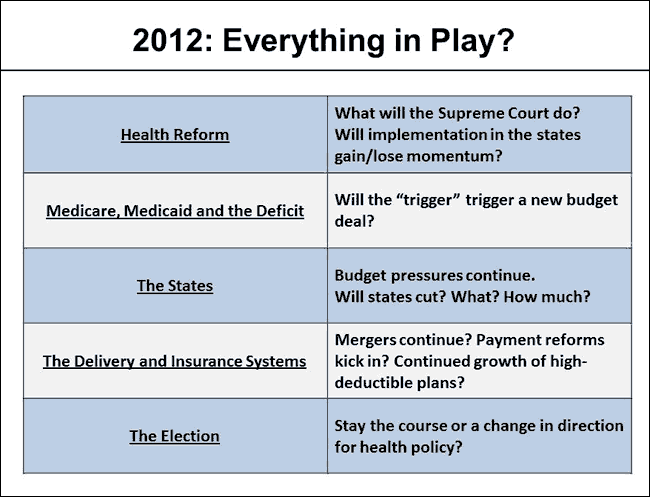Pulling it Together: 2012: The ACA, and More
What is remarkable about 2012 (and the current era in health policy) is how many big health policy issues and marketplace changes will be in play at the same time:
- HEALTH REFORM: There is the implementation of a historic but fragile health reform law, with a Supreme Court decision pending and so much hanging in the balance.
- MEDICARE AND MEDICAID: There are continuing debates about potentially big changes in Medicare and Medicaid, driven by the desire to reduce the deficit. With the collapse of the Super Committee triggering big cuts in defense and with the Bush tax cuts set to expire, there will be pressure to make a new deal to meet budget targets that protect defense spending and preserve at least some of the tax cuts. Complicating matters is the pressure to avoid major cuts in Medicare payment rates for physicians when the short-term “doc fix” expires. All this could cause policymakers to look again at savings and changes in Medicare and Medicaid, as well as the Affordable Care Act (ACA). While health reform attracts the most attention, these two public programs cover more than one hundred million low-income, disabled and elderly Americans. And, Medicare is unique as a health issue because, despite the clamor about health reform, it is the one health issue proven to move votes.
- OUTSIDE THE BELTWAY: Then there are the changes occurring outside the beltway. Faced with lingering budget pressures and the expiration of enhanced federal matching payments, states continue to cut back their Medicaid programs (mostly through provider payment reductions, since maintenance of effort rules prevent cuts in eligibility). States are also cutting other programs and services for low-income people. The health care delivery system continues to morph and change rapidly with mergers, consolidations, Accountable Care Organization (ACO) mania, and more. The insurance system continues to change as well. Insurers are experimenting with new payment arrangements while insurance itself is becoming less comprehensive with the growth of high-deductible plans. People continue to be hard-pressed by their out-of-pocket health care costs. Strikingly, the Census recently reported that the biggest factor driving people into poverty was their out-of-pocket health costs.
- THE ELECTION: Last, and potentially most significant of all, there will be an election in 2012. Elections matter hugely for policy directions, if not always substantive legislative changes, and quite obviously, if President Obama is unseated by any of the Republican candidates (and especially if the Senate changes hands at the same time), the direction of health policy could fundamentally change.
This graphic summarizes how much could be in play in 2012:

There is a tendency to think of this period in health policy as the early ACA years. To be sure, the ACA has and will make fundamental changes in the health care system. No doubt it is the new big thing and the big story. But it alone is not what is most remarkable about this year or the current era in health policy. What is unusual about 2012 is how many programs, issues, and changes are in play all at once. It is entirely possible that the court will uphold the law; nothing much will be done to “reform” (some would say harm) Medicare and Medicaid, despite budget and political pressures; and the President will be re-elected and policy directions will continue largely unchanged. Or, it may be that some of these tipping points will tip and others will not. Big changes or small, policy is generally better when it is informed by facts and analysis and made more accountable by good journalism. And no matter what happens in Washington many of the changes in payment and delivery unfolding in the marketplace will continue, and they warrant real assessment to determine if they are merely the latest fads, or if they represent real progress.For journalists it will be a target-rich environment. But with such a broad health policy beat, journalists will need to make choices about which stories to cover, and they will be hard pressed to get beyond the beltway where many of the most important stories will be found. It will be a challenging year for analysts too. There is a need for data and analysis on such a wide range of issues, and it will need to be generated in real time to be relevant and useful. Assessing the changes occurring in the marketplace is always a special challenge, because up-to-date data on the private market are difficult and sometimes impossible to find.
At Kaiser we will do our best to provide explanation, data and analysis, polling, and in-depth journalism, on as many of these issues as possible. And we will keep our eye on our special focus: the impact policy debates and marketplace changes have on people.
